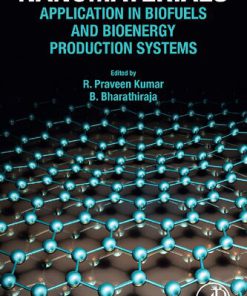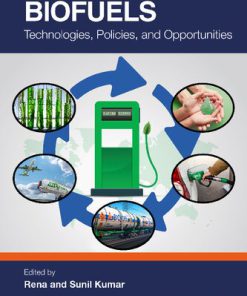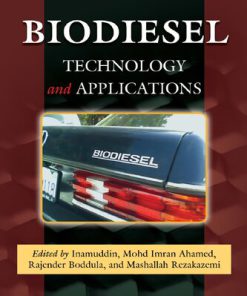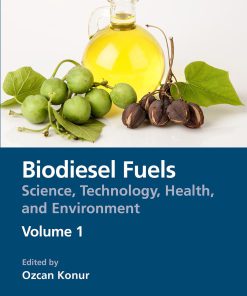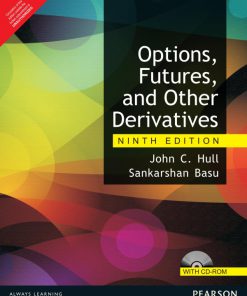Biofuels and Biodiesel 1st Edition by Chhandak Basu ISBN 1071613227 9781071613221
$50.00 Original price was: $50.00.$25.00Current price is: $25.00.
Biofuels and Biodiesel 1st Edition by Chhandak Basu – Ebook PDF Instant Download/Delivery: 1071613227 ,9781071613221
Full download Biofuels and Biodiesel 1st Edition after payment
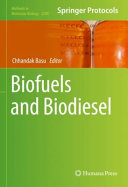
Product details:
ISBN 10: 1071613227
ISBN 13: 9781071613221
Author: Chhandak Basu
This volume provides methods and protocols on principle, production, molecular aspects, and sustainability of biofuel and biodiesel. Chapters are divided into four sections detailing biofuel production, biodiesel production, molecular genetics, biotechnology of biofuel and biodiesel production, economics, and sustainability of biofuel production. Written in the highly successful Methods in Molecular Biology series format, chapters include introductions to their respective topics, lists of the necessary materials and reagents, step-by-step, readily reproducible laboratory protocols, and tips on troubleshooting and avoiding known pitfalls.
Authoritative and cutting-edge, Biofuels and Biodiesel aims to be useful for researchers, students, and enthusiasts in the field of biofuel and biodiesel.
Biofuels and Biodiesel 1st Edition Table of contents:
Part I: Biofuel Production
Chapter 1: Overview of Current Developments in Biobutanol Production Methods and Future Perspectives
1 Introduction
2 Physio-Chemical Properties of Butanol
3 Methods of Butanol Production
3.1 Chemical Synthesis
3.2 Biochemical Synthesis
4 Butanol-Producing Microorganisms
5 Methods for Selection of Potential Substrates for Biobutanol Production
5.1 Sugarcane Bagasse
5.2 Algal Biomass as Substrate
5.3 Crude Glycerol
5.4 Lignocellulosic Biomass
5.5 Co-fermentation
6 Current Developments in Biobutanol Production with Integrated Product Recovery
7 Conclusion
References
Chapter 2: Biomass Pretreatment via Hydrodynamic Cavitation Process
1 Introduction
2 Materials
2.1 Biomass Powder Preparation
2.2 Biomass Slurry Preparation
2.2.1 Biocatalyst
2.2.2 Chemical Catalyst
3 Methods
3.1 Hydrodynamic Cavitation Reactor Configuration
3.2 The Operating Procedure Used for Biomass Pretreatment in HC Reactor
3.2.1 Before Starting the HC Reactor
3.2.2 Operating Procedure for HC Reactor
3.2.3 Before Stopping the HC Reactor
4 Notes
4.1 Drying of Biomass Materials
4.2 Priming Operation
4.3 Acetate Buffer for Biomass Slurry Preparation with Biocatalyst
5 Conclusion
References
Chapter 3: Algae: Biomass to Biofuel
1 Introduction
2 Classification of Algae
3 Cultivation of Algae
4 Factors Affecting the Algae Growth
5 Algae Biomass as a Potential Source of Biofuel
5.1 Direct Processing of Biomass
5.2 Biomass to Crude Oil and Its Processing
5.2.1 Extraction
5.2.2 Bioethanol Production
Physical Pretreatment
Comminution: Size Reduction of Biomass
Microwave/γ-Ray Irradiation
Ultrasonication
Biological Pretreatment
Physicochemical Pretreatment
Hydrothermal Pretreatment
Steam Explosion
Supercritical Carbon Dioxide
Chemical Pretreatment
Alkaline Pretreatment
Acid Hydrolysis
Enzymatic Hydrolysis
Fermentation
Distillation
5.2.3 Biodiesel Production
5.2.4 Biogas
5.2.5 Biohydrogen
5.3 Major Limitations in the Commercialization of Biofuel Production
6 Concluding Remarks
References
Chapter 4: Life Cycle Assessment of Biofuels
1 Introduction
2 Brief Methodological Overview of Life Cycle Assessment
Box 1: Interventions That May Be Considered in Life Cycle Assessment of Biofuels
3 Methodologies Applied to Environmental Aspects of Biofuel Life Cycles
3.1 The Emission of Substances Impacting Climate
3.2 Primary Energy Demand
3.3 Water Footprint
3.4 Depletion of Virtually Nonrenewable Abiotic Resources
4 For Which Purposes Are Biofuel LCAs Useful?
References
Chapter 5: Quantification of Branched-Chain Alcohol-Based Biofuels and Other Fermentation Metabolites via High-Performance Liq…
1 Introduction
2 Materials
2.1 Yeast Growth
2.2 Detection of Isobutanol and Other Fermentation Metabolites
2.3 Reagent Setup
3 Methods
3.1 Preparation of Pre-production and Production Cultures (See Note 1)
3.2 Procedure for Sampling for Isobutanol Analysis
3.3 Quantification and Data Analysis
4 Notes
References
Chapter 6: Jatropha curcas, a Novel Crop for Developing the Marginal Lands
1 Introduction
2 Why We Need Jatropha?
3 Jatropha Around the World
4 Importance of Jatropha
5 Advantage of Jatropha
6 Main Aspects of Using Jatropha
7 Botanical
7.1 Leaves
7.2 Root System
7.3 Flowering
7.4 Pollination
7.5 Fruits
7.6 Seed Yield
7.6.1 Main Factors Affect Seed Yield of Jatropha
7.7 Harvesting
8 Agricultural Practices
8.1 Pruning
8.2 Fertilization
8.3 Irrigation and Water Requirements
8.4 Weeds Control
8.5 Pests and Diseases
8.5.1 Diseases
8.5.2 Pests
8.6 Biological Control
9 Propagation Methods
9.1 Vegetative Propagation
9.1.1 Stem Cutting
9.1.2 Tissue Culture
9.2 Seed Propagation Method
9.3 Directly Sowing in the Field
9.3.1 Sowing in the Nursery
9.3.2 Seed Viability
10 Climate Conditions
10.1 Climate
10.2 Soil
11 Phytochemicals Properties of Jatropha
11.1 Jatropha as Biopesticides
11.2 Antifungal Properties
11.3 Pesticidal, Insecticidal, and Larvicidal Activity
12 Medicinal Uses
13 Jatropha and Marginal Lands
13.1 The Advantage of Utilizing Jatropha in Marginal Lands Includes
13.2 Jatropha and Rural Region Development
14 Conclusion
References
Part II: Biodiesel Production
Chapter 7: Protocol for Biodiesel Production by Base-Catalyzed Transesterification Method
1 Introduction
1.1 Biodiesel
2 Materials
2.1 Biological Raw Materials
2.2 Chemicals and Reagents
2.3 Equipment and Apparatus
2.4 Transesterification of Oils
3 Methods
3.1 Treatment of the Seeds and Oil Extraction
3.1.1 Feedstock Preparation
3.1.2 Mechanical Oil Extraction Method
3.1.3 Solvent Extraction Method
3.2 Determination of Percentage Oil Yield
3.3 Determinations of the Physicochemical Properties of the Starting Oil
3.3.1 Moisture Content
3.3.2 Specific Gravity
3.3.3 Boiling Point
3.3.4 Viscosity
3.3.5 Free Fatty Acid
3.3.6 Iodine Value
3.3.7 Saponification Value
3.3.8 pH
3.3.9 Peroxide Value
3.4 Steps Involved in Biodiesel Production
3.4.1 Reduction of the Fatty Acid in the Vegetable Oil
3.4.2 Transesterification
3.5 Separating the Reaction Products
3.6 Purification of the Biodiesel
3.6.1 Alcohol Removal from the Biodiesel
3.6.2 Biodiesel Washing
4 Notes
References
Chapter 8: Organosolv Pretreatment of Sorghum Stalks Using Glycerol
1 Introduction
2 Materials
2.1 Sorghum Stalks and Preprocessing
2.2 Solvents and Chemicals for Pretreatment
2.3 Pretreatment Reactor
2.4 Analysis of Pretreated Biomass
3 Methods
3.1 Preparation of Biomass
3.2 Pretreatment of Biomass
3.2.1 Glycerol Pretreatment
3.2.2 Acidic/Alkaline Glycerol Pretreatment
3.2.3 Washing of Pretreated Biomass
3.3 Enzymatic Digestibility of Pretreated Biomass
3.4 Composition of Pretreated Biomass
3.5 Structural Analysis of Pretreated Biomass
4 Conclusion
5 Notes
6 Calculations
References
Chapter 9: Seed Viability Test: A Semi-Throughput Method to Screen Oilseeds for Biodiesel Production
1 Introduction
2 Materials
2.1 Preparation of Seed Sample and Solution
2.1.1 Conditioning and Preparing of Oilseeds: Exposure of Tissues for Staining
2.1.2 Preparation of Solution
3 Methods
3.1 Seed Sampling Procedure
3.2 Screening Test
3.2.1 Principle
3.2.2 Methodology
3.2.3 Procedure for Staining and Assessment of Seed Viability
4 Oilseed Sampling
4.1 Sampling Intensity
4.1.1 Mixing and Dividing of Seed Samples
4.1.2 Mechanical Mixing and Dividing
4.1.3 Conical or Boerner Divider
4.1.4 Soil Divider
4.1.5 Modified Halving Method
4.1.6 Hand Halving Method
4.1.7 Physical Purity Analysis
4.2 Components of Purity Analysis
4.2.1 Pure Seed
4.2.2 Half Seed Rule
4.2.3 Other Crop Seeds
4.2.4 Inert Matter
5 For Staining Conditions
5.1 Correlation Between Seed Viability and FFA of Oil
6 Conclusion
References
Part III: Molecular Genetics and Biotechnology of Biofuel and Biodiesel Production
Chapter 10: RNAi-Based Gene Silencing in Sugarcane for Production of Biofuel
1 Introduction
2 Materials
2.1 Bacterial Strains and Plasmids
2.2 Reagents for Molecular Cloning
2.3 Materials for Transgenic Sugarcane Development and Screening
2.4 Solutions and Nutrient Media
2.4.1 Solutions
2.4.2 Nutrient Media
Medium for E. coli Transformation
Medium for A. tumefaciens Transformation
Media for Transgenic Sugarcane Development
3 Methods
3.1 Isolation of Gene-of-Interest from Sugarcane
3.2 RNAi Target Selection and Vector Construction
3.3 Introduction of RNAi construct into A. tumefaciens
3.4 Generation of Transgenic Plants
3.5 Screening of Transgenic Plants for Transgene Integration
3.5.1 PCR Analysis
3.5.2 Quantitative Real-Time RT-PCR for Quantification of Target Gene Expression
4 Notes
References
Chapter 11: Assessment of Molecular Diversity in Biofuel Crops
1 Introduction
2 Concept and Theory
3 Methods
4 Materials
5 Methods
6 Notes
References
Chapter 12: Genetic Transformation of Trichoderma spp.
1 Introduction
2 Materials
2.1 Laboratory Environment
2.2 Microorganisms and Biosafety
2.3 Instruments
2.4 Disposables and Glassware
2.5 Chemicals and Solutions
2.6 Microbial Cultivation Media
3 Methods
3.1 PEG-Mediated Protoplast Transformation
3.2 Agrobacterium-Mediated Transformation
4 Notes
References
Chapter 13: Purification and Amplification of DNA from Cellulolytic Bacteria: Application for Biogas Production from Crop Resi…
1 Introduction
1.1 Cellulolytic Bacteria in Biogas Production
1.2 Methods to Detect Cellulolytic Bacteria
2 Purification and Amplification of Genomic DNA from Cellulolytic Bacteria
2.1 Materials
2.1.1 Agarose Gel
2.1.2 Bacterial Genomic DNA Extraction
2.1.3 Polymerase Chain Reaction
3 Methods
3.1 DNA Extraction from Pure Bacterial Isolates
3.2 Agarose Gel Electrophoresis
3.3 Visualizing Separated Genomic DNA Bands
3.4 Polymerase Chain Reaction
4 Notes
References
Chapter 14: Cloning and Production of Thermostable Enzymes for the Hydrolysis of Steryl Glucosides in Biodiesel
1 Introduction
2 Materials
2.1 Biological and Chemical Materials
2.2 Equipment
3 Methods
3.1 Discovery of Thermostable Enzymes with SGase Activity
3.1.1 Cloning and Expression of Putative SGases
3.1.2 SGase Activity Test
3.2 Fluorometric Assay for Quantification of Steryl Glucosides in Biodiesel
3.2.1 Biodiesel Treatment
3.2.2 Glucose Quantification
3.2.3 SG Content Calculation
3.3 Production of SGase Enzymes in Fed Batch Fermentations
3.3.1 Stock Culture
3.3.2 Seed Culture Preparation
3.3.3 Fermentation Process
3.3.4 Enzyme Recovery
3.4 Enzymatic Treatment of Biodiesel with SGase Enzymes
3.4.1 SGase Treatment
4 Notes
References
Chapter 15: Recombinant Protein Production and Purification Using Eukaryotic Cell Factories
1 Introduction
2 Materials
2.1 Culture Media
2.2 Construction of Expression Vector
2.3 Transformation of P. pastoris by Electroporation
2.4 Screening Target Transformants
2.5 Expression of Recombinant Lipase
2.6 Protein Purification
2.7 SDS-PAGE Analysis
3 Methods
3.1 Construction of Expression Vector
3.2 Preparation of Competent Cells
3.3 Transformation of P. pastoris
3.4 Screening and Analyzing Target Transformants
3.5 Expression of Recombinant Lipase
3.6 Protein Purification
3.7 Protein Analysis by SDS-PAGE
4 Notes
References
Chapter 16: Designing and Constructing Artificial Small RNAs for Gene Regulation and Carbon Flux Redirection in Photosynthetic…
1 Introduction
2 Materials
2.1 Cultivation of E. coli and Cyanobacteria
2.1.1 Instruments for Cultivation
2.1.2 BG11 Culture Medium for Cyanobacteria
2.1.3 Luria-Bertani (LB) Broth for E. coli
2.1.4 BG11 Agar Plate Containing 5% (v/v) LB Broth for Conjugation of Cyanobacteria
2.2 Transformation of E. coli and Cyanobacteria
2.2.1 Instruments for Transformation
2.2.2 Transformation of E. coli
2.2.3 Transformation of Cyanobacteria
2.3 Plasmid Construction
2.3.1 Instruments for Plasmids Construction
2.3.2 Amplification of DNA Fragments
2.3.3 Purification of PCR Product
2.3.4 Golden Gate Assembly
2.3.5 DNA digestion by restriction enzyme
2.3.6 5′ End Phosphorylation of PCR Products
2.3.7 Ligation of DNA Fragments
2.4 Functional Validation of Promoters and Artificial sRNA Tools
2.4.1 Instruments for Validation
2.4.2 Reverse Transcription of RNA to cDNA
2.4.3 qRT-PCR
2.4.4 Detection of β-Galactosidase Activity
3 Methods
3.1 Plasmids Construction and Transformation into E. coli
3.1.1 Plasmids Construction
Golden Gate Assembly
Traditional Construction Methods
Digestion
5′ End Phosphorylation of PCR Products
Ligation
3.1.2 Transformation of E. coli and Verification of Transformants
3.2 Construction of Basic Plasmids for Artificial sRNA Tools and Verification of Promoters and Induction Systems
3.2.1 Construction of Universal Plasmids for Artificial sRNA Tool
3.2.2 Construction of Reporter Gene lacZ Positive Control Plasmid
3.2.3 Construction of Reporter Gene lacZ Universal Plasmid to Verify the Strength of Promoters and Induction Systems
3.3 Use the Reporter Gene System to Verify the Strength of Promoters and Induction Systems
3.3.1 Insert a Promoter or Induction System into a Universal Plasmid
3.3.2 Verify the Gene Expression Intensity of Reporter and Compare the Intensity of Promoters or Induction Performance of the …
3.4 Design and Construction of Artificial sRNA Tool
3.4.1 Design Principles of sRNA Target-Binding Sequences
3.4.2 Selection of Promoters
3.4.3 Construction of Plasmids for Transformation of Artificial sRNA Tool
Construction of Plasmid for Single Specific Gene Suppression by Artificial sRNA Tool
Construction of Plasmid for Multiple Specific Gene Suppression by Artificial sRNA Tool
Construction of Inducible Artificial sRNA Tool
3.4.4 Verification of Artificial sRNA Tool
3.5 Cultivation and Transformation of Cyanobacteria
3.5.1 Preparation of Culture Medium for Cyanobacteria
3.5.2 Cultivation Condition of Cyanobacteria
3.5.3 Enrichments of Cyanobacteria
3.5.4 Subcultivation of Cyanobacteria
3.5.5 Transformation of Cyanobacteria
Conjugation of Cyanobacteria
Natural Transformation of Cyanobacteria
4 Notes
References
Chapter 17: Sorghum as Biofuel Crop: Interdisciplinary Methods to Enhance Productivity (Botany, Genetics, Breeding, Seed Techn…
1 Botany, Genetics, and Breeding
1.1 Nomenclature
1.2 Sorghum as Biofuel Crop
1.3 Sorghum Origin and Domestication
1.4 Alternate Hypothesis: Origin of Sorghum Cultivation
1.5 Distribution
1.6 Classification and Systematic Position
1.7 Sorghum Taxonomy
1.8 Races of Sorghum and Its Characteristics
1.9 Biomass Production
1.10 Genetics of Biofuel Syndrome
1.11 Importance of Mutant bmr Trait
1.12 Breeding Methods
1.13 Genetic Resources Suitable for High Biomass
1.14 Institutes for Conservation of Sorghum Germplasm
1.14.1 International Crops Research Institute for Semi-Arid Tropics (ICRISAT), Hyderabad, India (https://www.icrisat.org)
1.14.2 Indian Institute of Millet Research (IIMR), Hyderabad, India (www.millets.res.in)
1.14.3 National Bureau of Plant Genetic Resources (NBPGR), New Delhi, India (www.nbpgr.ernet.in)
1.14.4 The Ramiah Gene Bank, Tamil Nadu Agricultural University, Coimbator (www.tnau.ac.in)
2 Seed Technological Intervention for Higher Productivity in Sorghum
2.1 Pre-sowing Seed Treatment
2.1.1 Principle
2.1.2 The Physiological Basis for Seed Hardening
2.1.3 Beneficial Effects of Seed Hardening
2.1.4 Methodology
2.1.5 Flow Chart of Sorghum Seed Hardening
3 Ethanol Production Process
3.1 Basic Steps in Ethanol Production
3.1.1 Pretreatment
3.1.2 Hydrolysis
Acid Hydrolysis
Enzymatic Hydrolysis
3.1.3 Fermentation
3.1.4 Thermochemical Processes
3.2 Inhibitory Compounds and Their Impact on Microorganisms
3.3 Methods of Ethanol Extraction from Sorghum
3.4 Pilot Plant Study
References
Chapter 18: Optimization of Micropropagation and Genetic Transformation Protocols for Paulownia elongata: A Short Rotation Fas…
1 Introduction
2 Materials
2.1 Plant Tissue Culture Medium and Growth Regulator Stocks
2.2 Disinfection of the Explants
2.3 Explant Excision and In Vitro Culture
2.4 Plantlet Acclimatization
2.5 Genetic Transformation
3 Methods
3.1 Seed Sterilization and Germination
3.2 In Vitro Donor Plant Culture and Priming with BAP
3.3 Explant Establishment and Shoot Bud Induction
3.4 Shoot Elongation and Rooting
3.5 Acclimatization and Transfer to the Greenhouse
4 Heat Map Analysis of Data
5 Agrobacterium tumefaciens EHA105 Mediated Genetic Transformation
5.1 Molecular Identification of Putative Transgenic Plants
5.1.1 Polymerase Chain Reaction (PCR)
5.1.2 Reverse transcription-PCR
6 Conclusions
7 Notes
References
Part IV: Economics and Sustainability of Biofuel Production
Chapter 19: Economics of Biofuel Production: A Case of Sorghum and Pearl Millet in India
1 Introduction
2 Objectives of the Study
2.1 Objectives of the Study
3 Research Methodology
3.1 Study Area, Sample, and Data Analysis
4 Findings of the Study
4.1 Socioeconomic Analysis: Findings of Baseline Survey
4.2 Multi-locational Trials (MLTs) of High Biomass Varieties
5 Drivers and Barriers for Bioethanol Production in India
5.1 Drivers
5.2 Barriers
6 Life Cycle Analysis of Jowar and Bajra Feedstocks
6.1 Life Cycle Assessment Methodology
6.2 Approach
6.3 Process Overview
6.4 Life Cycle Assessment System
6.4.1 Farming and Transportation of the Feedstock
6.4.2 Land Requirement
6.4.3 Water Requirement
6.4.4 Chemicals Required
6.4.5 Diesel Requirement
6.4.6 Electricity Requirement
6.4.7 Seed Requirement
6.4.8 Labor Requirement
6.4.9 Transportation of Feedstock
7 Ethanol Production
7.1 Pretreatment
7.1.1 Dilute Acid (DA)
7.1.2 Steam Explosion
7.1.3 Hot Water
7.1.4 Dilute Alkali
7.1.5 Alkali Hydrogen Peroxide
7.2 Simultaneous Saccharification and Co-fermentation
7.3 Distillation and Steam Production
8 Ethanol Transportation
9 Blending
10 Combustion
11 Results
11.1 Net Energy Ratio
11.2 Net Energy Balance
11.3 Net Energy Balance/kL of Bioethanol
11.4 Net Carbon Balance
11.5 Net Carbon Balance/kL of Bioethanol
11.6 % Carbon Emission Reduction
12 Comparative Analysis of Second-Generation Biofuels to First-Generation Biofuel
13 Allocation Approach
14 Conclusions
15 Note
References
Chapter 20: Biofuels and Sustainability
1 Background
2 Sustainability Impacts of Biofuels on the Environment
2.1 Food Security
2.2 Biodiversity Loss
2.3 Air Pollution
2.4 Water Requirement and Pollution
2.5 Cost
2.6 Rural Development
2.7 Impact on Land
2.8 GHG Emissions
3 Land-Use Impact in Life Cycle Assessment (LCA)
4 Involvement of Genomics for Biofuel Sustainability
5 Crop Improvement Using CRISPR/Cas9 Gene Editing System
5.1 Maize (Zea mays)
5.2 Cotton (Gossypium hirsutum)
5.3 Camelina (Camelina sativa)
5.4 Jatropha (Jatropha curcas)
5.5 Soybean (Glycine max)
6 Use of CRISPR Gene Editing Tool in Cyanobacteria and Microalgae
7 Conclusion
References
Index
People also search for Biofuels and Biodiesel 1st Edition:
a biofuel is
is biofuel a chemical reaction
traditional biofuels
a biofuel produced from corn or sugar cane
is biomass biogas and biofuels renewable
Tags:
Chhandak Basu,Biofuels,Biodiesel
You may also like…
Technique - Nanotechnology
Technique - Fuel Technology
Uncategorized
Computers - Networking
Biodiesel Technology and Applications Technology and Applications 1st Edition Inamuddin
Business & Economics - Markets
Biology and other natural sciences - Biotechnology
Liquid Biofuels: Fundamentals, Characterization, and Applications Krushna Prasad Shadangi




